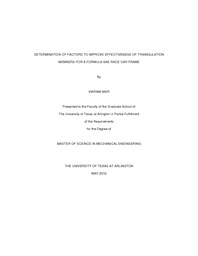| dc.contributor.author | Nair, Vikram | en_US |
| dc.date.accessioned | 2012-07-25T19:07:56Z | |
| dc.date.available | 2012-07-25T19:07:56Z | |
| dc.date.issued | 2012-07-25 | |
| dc.date.submitted | January 2012 | en_US |
| dc.identifier.other | DISS-11693 | en_US |
| dc.identifier.uri | http://hdl.handle.net/10106/11026 | |
| dc.description.abstract | This thesis suggests which factors have significant effect on the torsional and flexural stiffness of a space frame without contributing excessively to its weight. These factors are used as design variables to display the interaction plots generated by performing a Design of Experiments (DOE) using the Hyperstudy tool in Hyperworks by Altair®. The DOE will also provide a mathematical model which can help predict the responses by varying several factors in the design. The node - element models are created in ANSYS classic and are analyzed for various load cases that are representative of the loads on a formula SAE chassis during operation. The main focus is to maximize stiffness to weight ratio for a simple rectangular space frame while keeping making sure the various stresses acting along the section is under the yield load. | en_US |
| dc.description.sponsorship | Woods, Robert L. | en_US |
| dc.language.iso | en | en_US |
| dc.publisher | Mechanical Engineering | en_US |
| dc.title | Determination Of Factors To Improve Effectiveness Of Triangulation Members For A Formula SAE Race Car Frame | en_US |
| dc.type | M.S. | en_US |
| dc.contributor.committeeChair | Woods, Robert L. | en_US |
| dc.degree.department | Mechanical Engineering | en_US |
| dc.degree.discipline | Mechanical Engineering | en_US |
| dc.degree.grantor | University of Texas at Arlington | en_US |
| dc.degree.level | masters | en_US |
| dc.degree.name | M.S. | en_US |

